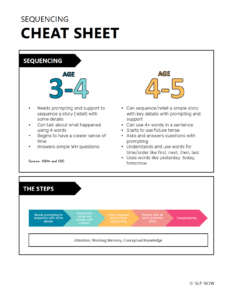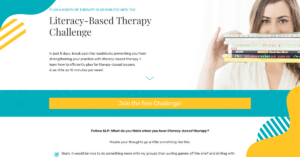This is a guest blog post by Monica, a school-based SLP, all about the importance of sequencing in narrative therapy and why it shouldn’t be targeted in isolation!
The Importance of Sequencing
I want to expand on how sequencing shouldn’t be targeted in isolation, but in the context of narrative therapy.
I hope that this post will also help give you some language for explaining your goals to parents during IEP meetings and why it’s important to work on them. I’ve found that I strengthen relationships with my student’s families when I give them a lot of information and explain my next steps because it shows that I’m always planning for their student’s future.
Therapy Ideas
If you want to jump straight to therapy ideas, head over to this blog post, How To Target Sequencing. I talked about ways to target sequencing in therapy sessions (and possible goals!). Keep in mind that sequencing is just one part of the overall literacy-based therapy framework!
Sequencing and Narratives
First things first, I’m going to clarify what I’m talking about when I say sequencing. The term “sequencing” gets thrown around a lot and can refer to sequencing steps to follow a direction or sequencing to retell a story.
If you’re looking for following directions resources, I’m going to direct you to these excellent blog posts:
Following Simple Directions: Speech Therapy Activities & Worksheets
Teaching How to Follow 2 – and 3 – Step Sequential Directions
In those posts, you’ll find that there may be many things that you want to target, like executive functioning (hello working memory!), vocabulary, and grammar. It’s also vital for therapy and materials to be contextualized (think real-life situations) instead of using a deck of cards because it’s convenient.
I know, I know! Sometimes it is just easier to use something we’re used to, but the research is pointing towards decontextualized therapy being more like working on making the leaves of a tree grow instead of the roots and trunk (which would be contextualized therapy).
To give us some context, let’s review where your students should be developmentally with telling stories. We’ll keep in mind that the population these studies were focused on probably does not match a population that needs more support, so take it with a grain of salt if your population isn’t a homogenous group.

Click here to access the SLP Now Sequencing Cheat Sheet!
From ages five and up, we can also use Common Core State Standards as a developmental framework for what would be expected of a student at that age.
When we look at the developmental profile and common core standards, basic sequencing should be developed around 3-4 years old, and 4-5 year olds should be able to sequence/retell basic stories.
Kamhi (2014) talked about how sequencing shouldn’t be targeted in isolation and that working in the contexts of narratives is the perfect way to make it relevant to a student’s life.
This article talks about working on sequencing with contextualized narrative intervention and that clinicians have wrongly assumed that you need to work on sequencing on its own because sequencing is tested as its own in subtests on formal assessments. Narratives do encompass a large part of a student’s day, whether academic or their ability to communicate with others.
The article also states that “correctly recalling the sequence of events thus depends solely on attention and memory processes”. We can reduce the memory demands of retelling a story using macrostructure or “the logical, conceptually coherent order of events” (Kamhi, 2014). We know that macrostructure = story grammar parts and that microstructure (ex: temporal/causal words and grammar) is also an important part of narratives.
Sequencing and Working Memory
I also reviewed three articles (Singer & Bashir, 2018 ; Montgomery, Magimairaj & Finney, 2010; Boudreau & Contanza-Smith, 2010) that talked about how when we’re working on sequencing, we really want to target working memory. If we are only working on having a student listen to directions and do them, it’s targeting short-term memory skills that won’t generalize. By working on sequencing with narratives, you’re targeting a more complex system that will help with later comprehension. When we use narrative therapy, we’re teaching students to create a schema in their minds with story grammar.
We’re giving them a way to organize information and to know what to grab on to. This frees up their working memory to shift through the information given in a story to retell it and answer comprehension questions.
References
Boudreau, D., & Costanza-Smith, A. (2011). Assessment and treatment of working memory deficits in school-age children: The role of the speech-language pathologist. Language, Speech, and Hearing Services in Schools, 42(2), 152–166.
Kamhi, A. G. (2014). Improving Clinical Practices for Children With Language and Learning Disorders. Language, Speech, and Hearing Services in Schools, 45(2), 92–103.
Montgomery, J. W., Magimairaj, B. M., & Finney, M. C. (2010). Working Memory and Specific Language Impairment: An Update on the Relation and Perspectives on Assessment and Treatment. American Journal of Speech-Language Pathology, 19(1), 78–94.
Singer, B. D., & Bashir, A. S. (2018). Wait…What??? Guiding Intervention Principles for Students With Verbal Working Memory Limitations. Language, Speech, and Hearing Services in Schools, 49(3), 449–462.




Reader Interactions